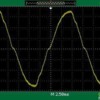John, Is the chopped sign wave created in the brick or in the Z controller? I always thought if you send a full wave into a Z controller, a full wave would come out.
The controller is what "chops" the wave. The actual z1000 brick puts out a pure sine wave at about 20VAC(no load) MTH bricks as well as Lionel PH180 bricks all supply pure sine waves. Electronic controllers (most of them) vary the voltage by "chopping" the output wave. In effect they are turning the transformer on and off really fast.
the chopped sign wave comes from the electronic transformers like MTH the older z4000 transformers.
The Z4000 is a rather unique transformer in that it is electronically controlled, but produces a sine wave that is acceptable to engines that won't run on "chopped" waveforms. Though pure would not be my first choice in how to describe the waveform, the Z4000 does produce a waveform much closer to a pure sine wave than any other electronic control I am aware of, and will operate any engine I am aware of without problems that 'chopped' wave transformers can have. ( QSI/early PS1 engines.)
In the world of O gauge transformers the Z4000 is classified as a "pure sine wave" transformer.
the z1000 is only a controller to adjust the voltage output to the track!
Actually the Z-1000 is the designation for the transformer brick, not the controller. there are also Z-750's and Z-500's that use the same controller.
As for the controller, yes, it is only a controller to adjust the voltage output to the track, which it does by 'chopping' off part of the waveform. The bricks provide pure 60 cycle AC, the electronic controllers chop it.
JGL















